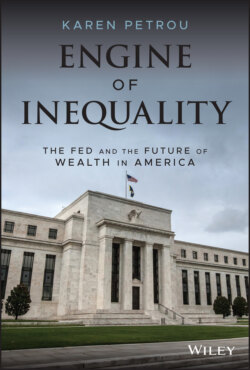Читать книгу Engine of Inequality - Karen Petrou - Страница 21
The Inequality Engine
ОглавлениеAs these data demonstrate, the fundamental engine of economic inequality is that the more you get, the more you keep unless gigantic market downturns or fiscal policy (e.g., inheritance taxes) takes it away. Wealthy households earning high returns on financial assets buoyed by rising market prices that are not purchased with debt acquire larger and larger shares of national wealth. In fact, 2 percentage points in wealth share equals 14 percentage points of total annual household income – it's a lot harder to get equal by earning your way to the top.31 Given this, it's no wonder that economists honor F. Scott Fitzgerald's memorable get-rich-quick hero, using the “Great Gatsby Curve” to describe the relationship of income to wealth and resulting economic inequality.
The inequality engine also works in reverse. Just as the more you have, the more you keep absent policy intervention, so it is also that the less you have, the less you retain. Once set on a downward path due to lost wealth or income, it is increasingly difficult to recover lost momentum. For white male workers in the bottom half of the US income distribution, lost working hours may have been the primary source of income inequality over the past 52 years.32 Working hours generally decline during recessions but then fail to recover when economists believe prosperity has returned. Often, white men who lose hourly wages also exit the workforce, making them disappear from traditional counts of the unemployed but of course heightening their own economic distress as well as that of their families. As the authors of this study conclude, “The cycle drives the trend.”
Although the US is renowned for its economic optimism, before the pandemic only about a third of Americans believed that their children would do better than they did.33 They have a reasonable hope of seeing this come true if they're white and already doing well. Being non-Hispanic white, over forty, and having college-educated parents boosts the next generation's income by three times and its wealth is sixfold more than less demographically advantaged families. About half of these differences are due to a wealth-generated head start, not the natural advantage in the second generation of also being college educated.34
In Denmark – one of the world's most equal nations – it takes only two generations for low-income families to enter the middle class; in the US before COVID, it took five. Post-COVID, it's likely to take still more unless policy solutions – including the financial ones I lay out in this book – restore realistic hope of doing well by working hard.35
